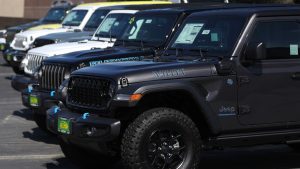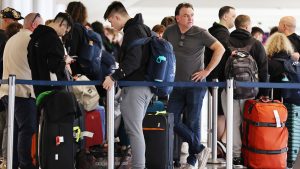Details emerging about Trump’s nuclear testing resurrection

Just before Halloween, the world got a bit of a scare when President Donald Trump announced the U.S. military would immediately resume testing its nuclear weapons. The announcement ended what had been a 33-year pause on testing.
Reporters asked the president for clarification while he was aboard Air Force One. When asked if he was talking about “literally resuming underground nuclear detonation tests,” President Trump said, “You’ll find out very soon. But we’re going to do some testing. Other countries do it. If they’re going to do it, we’re going to do it.”
Trump’s remarks came just minutes before meeting with Chinese President Xi Jinping, according to Reuters, and appeared to be directed at rival nuclear powers China and Russia.
No nuclear detonations, for now
The United States already tests its nuclear launch and delivery systems, but those tests do not include live detonations. Energy Secretary Chris Wright told Fox News that the new testing the president is referring to will not involve nuclear explosions either.
That said, Congress has ensured since the 1990s that the U.S. retains the authority to perform underground nuclear tests if needed.
In 1963, the U.S. and most other nuclear powers signed the Partial Test Ban Treaty, which prohibits atmospheric, underwater and space tests but allows underground testing.
“So, it is technically legal for nuclear weapons states like the United States or Russia or China to test underground,” Daniel Schaub, a political science instructor at the University of Nebraska, told Straight Arrow News.
While legal, Schaub noted that it’s been decades since most nations have done so. “There’s been a few exceptions to this. India and Pakistan tested in the late 90s. Pakistan got its nuclear weapons in the late 90s. And North Korea has been testing sort of on and off again throughout the 21st century.”
A treaty signed, never ratified
Another international agreement — the Comprehensive Nuclear Test Ban Treaty (CTBT) — would outlaw all nuclear testing regardless of where it happens. The U.S. signed that treaty in 1996 but never ratified it.
“The Senate has yet to give their stamp of approval on it,” Schaub said. “And it’s unlikely that they will because it’s been several consecutive administrations that have decided this isn’t in the interest of the U.S. national security to completely limit nuclear testing.”
That decision has become even more relevant since Russian President Vladimir Putin revoked his country’s ratification of the CTBT in 2023, bringing Moscow’s stance in line with Washington’s.
When would underground testing be justified?
To better understand when such testing might be warranted, SAN spoke with retired Air Force Lieutenant General Mark Weatherington, a former deputy commander of U.S. Global Strike Command.
“I think the United States conducted just a little over a thousand tests between the late 1940s and 1992,” Weatherington said. “We’ve got an exquisite set of data, a lot of mathematics, a lot of advanced modeling techniques. So, I think there’s a general feeling that we can do modeling, simulation, advanced analytics and high-powered computing and really understand all we need to understand from the existing data.”
But with the U.S. nuclear triad currently undergoing modernization — and with Russia and China updating or expanding their arsenals — Weatherington noted that there could come a point where testing makes sense.
“If there’s concern with the reliability of the stockpile or if there’s concern that we’re redesigning the weapons to a degree that might require some additional data or a better understanding — or just a confirmation or validation of what we understand about their reliability and their performance — then it may warrant conducting a test,” he said.
If tests were to occur, they would likely take place in the New Mexico or Nevada deserts, where much of America’s nuclear testing occurred in the past.
The benefits and risks of nuclear testing
There are both advantages and dangers to resuming underground nuclear tests.
New tests could generate valuable data, help validate new weapons designs, and serve as a deterrent. As Schaub put it, “In some ways, nuclear weapons are a familiar thing. They’re very big, very powerful bombs that, in theory, hopefully deter other actors from using those very weapons against us. And so maybe leaders, maybe the administration is turning to that to, sort of, mitigate the uncertainty in international politics right now.”
But the potential fallout — both political and environmental — could be severe. “If Russia takes this as a signal, ‘well, now it’s time to build up our stockpile since the United States is,’ that could be problematic,” Schaub warned.
He also noted that China, which has conducted relatively few nuclear tests, might benefit from a return to nuclear testing. “They don’t really have those sort of refined techniques to predict the effectiveness of these weapons.”
Even non-nuclear states such as Iran could interpret a U.S. resumption of testing as a green light to pursue weapons programs of their own. “We just don’t know how many of these actors, these foreign states will interpret what it is that the administration is saying,” Schaub said.
International reaction
The Kremlin responded cautiously to Trump’s announcement. “President Trump mentioned in his statement that other countries are engaged in testing nuclear weapons. Until now, we didn’t know that anyone was testing,” Kremlin spokesman Dmitry Peskov told reporters.
He stressed that Russia’s recent tests of a nuclear-powered cruise missile and torpedo “were most definitely not nuclear weapons tests.”
“I want to recall President Putin’s statement, which has been repeated many times: if someone departs from the moratorium, Russia will act accordingly,” Peskov added.
Meanwhile, China called on Washington to maintain the global moratorium on testing.
For now, the U.S. is not planning any live detonations — just continued testing of its launch and delivery systems. But the debate has rekindled long-dormant questions about deterrence, modernization and global stability.
As Schaub pointed out, “There’s certainly a lot of evidence that sometimes we miscommunicate with one another.”
And with nuclear powers modernizing their arsenals, that kind of miscommunication could have consequences far more dangerous than words.
The post Details emerging about Trump’s nuclear testing resurrection appeared first on Straight Arrow News.





